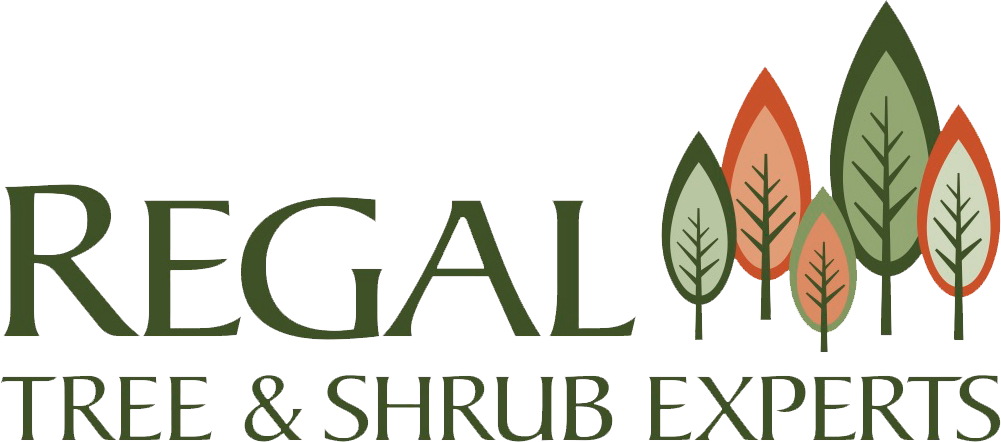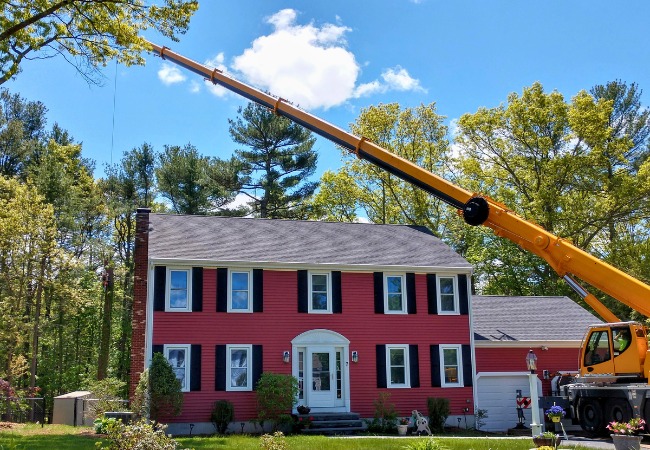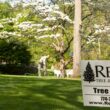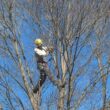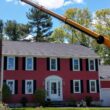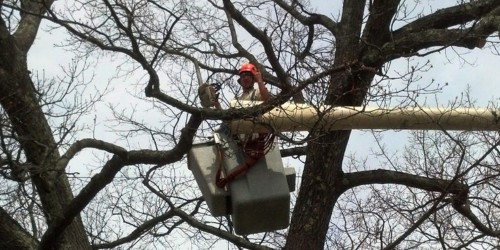Have you noticed dark, striped bands on your beech leaves? That could be the first visible sign of beech leaf disease – a serious and often fatal condition affecting both native and ornamental beech species. That’s why we’re covering the most common questions about beech leaf disease and what you can do to protect your trees in Greater South Easton.
Key Takeaways
- Beech leaf disease (BLD) is a deadly threat to all beech species in Massachusetts, with dark banding on leaves being the most distinctive symptom.
- The disease is caused by microscopic nematodes that feed on beech leaves, typically from late June through October, and can kill trees within 2-7 years.
- While there’s no cure for BLD, preventive care like proper fertilization, stress reduction, and maintaining tree health can help make beeches more resistant to infection.
- A promising experimental treatment using the fungicide, Thiabendazole, has shown success in reducing symptoms and nematode presence, and received EPA approval for use in Massachusetts in 2024.
- Early detection and professional arborist consultations are critical, since prompt treatment may help extend a tree’s life.
Frequently Asked Questions About Beech Leaf Disease in Massachusetts
Beech leaf disease (BLD) is an emerging threat in Massachusetts, and we’ve begun getting calls from many homeowners worried about the look of the leaves of their beeches. To help reduce anxiety about beech tree health, we’ve answered some common questions homeowners have about BLD and what you can do about it.
What causes beech leaf disease?
Beech leaf disease is caused by a microscopic worm called Litylenchus crenatae ssp. mccannii (or Lcm for short), which feeds on beech tree leaves, not the wood. These nematodes start feeding on buds and leaves in mid-summer, usually from late June through October. The damage they cause shows up the following spring as dark bands, curled leaves, or even buds that fail to open.
As they feed, the nematodes lay eggs in the leaves, creating the next generation of Lcm that continues attacking the tree until it eventually dies from the disease.
While researchers are still learning how Lcm spreads, we do know it can travel short distances through rain and wind – either between trees or from one part of the canopy to another. For longer distances, the nematodes may hitch a ride on birds or insects, which unknowingly introduce them to new beech trees.
How long has beech leaf disease been in Massachusetts?
BLD is a relatively new concern throughout the United States, as the first detection of the disease was in Ohio in 2012. However, the first case of BLD in Massachusetts was in June 2020 in the town of Plymouth. Since then, every county in Massachusetts has reported at least one case of BLD.
“Beech trees are everywhere in Massachusetts – they make up about 10% of our forests, and a lot of homeowners have them as shade trees, too. The tough part is, once a tree gets beech leaf disease, there’s no way to stop it completely. We can slow it down and try to protect nearby trees, but the threat of the disease if very real for residents in our area.” – Adam Winsor, Plant Health Care Manager, Regal Tree
Will beech leaf disease kill my trees?
Yes, BLD is a fatal disease, with a startlingly high mortality rate for young trees. The high fatality rate for trees makes it vital to talk to an arborist as soon as you notice any symptoms and try to treat them early to help prolong the life of your tree.
Which beech trees are vulnerable to beech leaf disease?
Unfortunately, all beeches are vulnerable to BLD. This includes not just the American beech, but also European, oriental, and Chinese beeches.
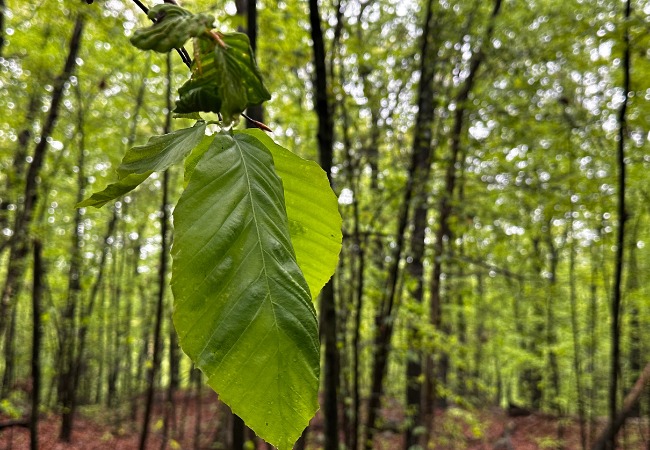
Close-up of beech leaves infected with beech leaf disease. Photo by Magpieturtle, CC BY-SA 4.0, via Wikimedia Commons
What are the symptoms of beech leaf disease in Massachusetts?
Beech leaf disease is aggressive, but fortunately, its symptoms are distinct enough that you can often spot them early – if you know what to look for.
The most visible sign is dark green banding between the veins of the leaves. These bands are easier to see when sunlight filters through the canopy, especially when viewing the leaves from below.
As the disease progresses, additional symptoms may include:
- Cupping or otherwise distorted leaves
- Leaves that look like leather
- Leaf drop before the fall
- Smaller or patchier growth
- Leaves developing a copper color
- The death of buds
BLD will typically kill untreated trees in two to seven years, depending on the tree’s condition and age. Young trees are more likely to die quickly from BLD than mature ones.
Can you prevent a tree from getting beech leaf disease?
While there’s no definitive way to keep your trees 100 percent safe from a BLD infection, you can take action to make your tree more resistant to a BLD infection. Some of the things we recommend doing to protect your trees include:
- Keep Trees Unstressed: Keeping your trees unstressed and healthy will lower the risk of an insect or disease problem. Some things you can do in the summer include putting organic mulch down, watering during a drought, and keeping pruning light or waiting until winter.
- Fertilize Trees: Fertilizers provide extra nutrition for a tree when a soil test reveals a deficiency. Additionally, phosphite fertilizers can boost a tree’s vitality and natural defense against BLD.
- Plant a Variety of Trees: When you decide to add new saplings to your property, consider planting various species, rather than just beeches. While they are great trees, having a diverse range of species will ensure that one disease cannot wipe out your entire landscape.
- Report Any BLD Symptoms: If you notice symptoms of BLD in your tree or those nearby, report it to the Massachusetts state government.
Is there a cure for beech leaf disease?
Right now, there is no cure for beech leaf disease. However, some experimental treatments may help slow the disease’s progress and reduce the damage to infected trees. Arborists and researchers are still studying these treatments to understand how well they work and what long-term effects they may have.
One of the most promising options so far is a fungicide called Thiabendazole, the active ingredient in ArboTect 20-S. In recent studies, trees treated with this product showed fewer symptoms and had lower numbers of the nematodes that cause the disease compared to untreated trees.
While this isn’t a permanent solution, it offers hope for slowing the spread and buying more time for infected beeches. In 2024, the EPA approved a special label for Arbortect 20-S to treat BLD in Massachusetts, allowing certified applicators to use it legally on affected trees.
What should you do when you believe your tree has a beech leaf disease infection?
If you notice dark banding on your beech leaves or other signs of beech leaf disease, don’t wait – call a Certified Arborist as soon as possible. Early action won’t stop the disease, but it can help slow its progress and protect nearby trees.
An arborist will inspect your tree, confirm whether it’s infected, and recommend the best next steps. If the tree still has a chance, they may recommend a tree preservation plan with targeted treatments to help extend its life and reduce the risk of spread.
If the tree is too far gone, removal may be the safest option. Taking down severely affected trees can prevent property damage and help stop beech leaf disease from spreading to healthy beeches nearby.
Worried About That Dark Banding? Let Regal Tree Take a Closer Look
If you think your beech tree may be showing signs of beech leaf disease, it’s important to act quickly. While there’s no cure, a targeted plant health care plan can slow the disease’s progress and help reduce the risk of it spreading to other trees on your property.
Regal Tree has been treating Greater South Easton trees for over a decade, and we bring that experience and expertise to every job. We can treat your beech trees or remove them if they now pose a risk to your property. Call us today at 774-719-2450 or request a quote online.
